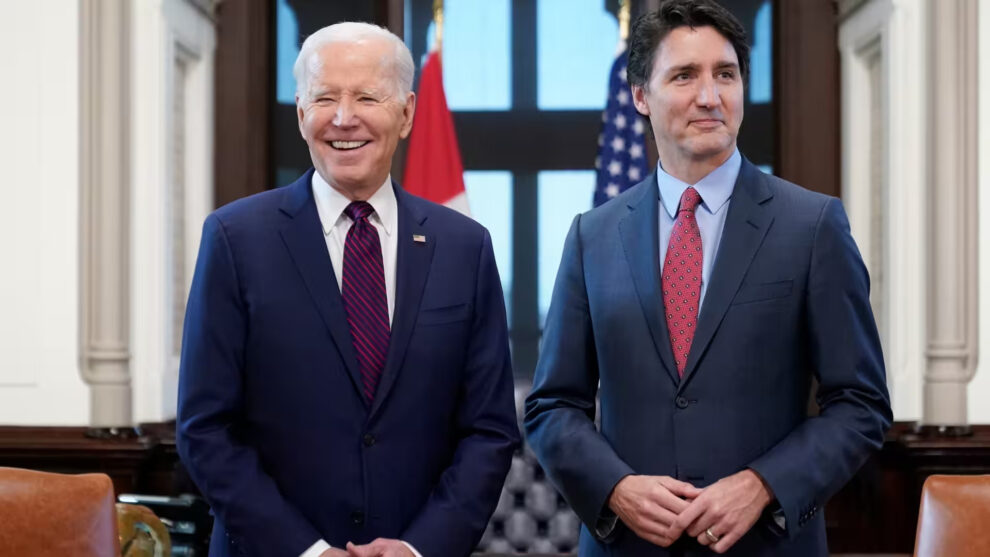The Biden administration has been asking Ottawa to consider reimposing visa requirements for Mexican nationals visiting Canada, CBC News has learned.
At issue is the sharp increase in illegal crossings from Canada into the United States: Mexicans don’t need a visa to travel to Canada, while the U.S. requires a visa for Mexicans to enter. American border officials say some Mexican nationals are using Canada’s visa-free rule to fly into the country and then cross south illegally into America.
The Conservative government under Stephen Harper created a visa requirement in 2009 for Mexicans to stem the flow of asylum claims from Mexico. The Trudeau government relaxed it in 2016.
In an interview with CBC News chief political correspondent Rosemary Barton, U.S. Homeland Security Secretary Alejandro Mayorkas — whose department oversees border security and the enforcement of U.S. immigration laws — says the Biden administration has asked Canada to consider putting back in place the visa requirements for Mexican nationals.
“We talk about this issue and many issues that impact the migration of people,” said Mayorkas in an interview airing Sunday on Rosemary Barton Live. “I think that’s a decision that the Canadian officials are going to make.”
Mayorkas was in Ottawa for the 2023 Canada-United States Cross-Border Crime Forum, alongside Attorney General Merrick Garland, and their Canadian counterparts, Public Safety Minister Marco Mendicino and Justice Minister David Lametti.
U.S. Customs and Border Protection (CBP) data show a spike in migrants entering the U.S. from Canada after Trudeau lifted the visa requirement in December 2016: there were 1,169 apprehensions of Mexicans the year before the requirements were lifted but the number nearly doubled to 2,245 in 2018, a year after the requirements were lifted.
More recently, there’s been a spike in illegal crossings through Canada: U.S. CBP reported 1,999 Mexicans being stopped trying to enter the U.S. between ports of entry at the northern border in the first six months of this fiscal year, compared with 882 for all of last year.
(The number of border crossers apprehended by U.S. Border Patrol agents along the entire 8,800-kilometre-long Canada-U.S. border is tiny compared with those entering the U.S. illegally from Mexico: 738,780 Mexican nationals were apprehended along the U.S.-Mexican border last year.)
Ottawa says no plans to change visa-free status for Mexican visitors
Both publicly and privately, U.S. officials have suggested that people who can’t get into the U.S. lawfully have an incentive to travel to Canada and try entering illegally. Human smuggling networks are cashing in, moving people who are fleeing poverty and violence in Mexico, and using Canada as a pitstop to the American dream.
A senior Canadian government source with knowledge of the discussions between Canada and the U.S. confirms Mayorkas has indeed brought up the issue of visa-free travel for Mexicans multiple times this year — including in meetings with Mendicino and Sean Fraser, Minister of Immigration, Refugees and Citizenship.
The official said this issue “hasn’t been the main focus of conversations by any means,” but acknowledges “we know this is a concern” for the U.S. The official characterised the discussions by the Biden administration with the Canadian ministers by saying “They want to put on our radar that this is something that they’re monitoring.”
Despite Washington’s concerns, the Trudeau government says there are no plans for Canada to change the visa-free status for Mexican visitors.
“Canada works closely with both the United States and Mexico on shared challenges, including border security. In collaboration with these partners, Canada has been monitoring migration trends from Mexico and has no plans to reimpose the visa requirement at this time,” a spokesperson for Fraser said in a statement.
‘Hemispheric challenges require hemispheric solutions’
Meanwhile, the Biden administration last week announced plans to establish immigration processing centres throughout Latin America in an attempt to help slow down the number of migrants coming to the U.S. The first processing centres will open in Guatemala and Colombia, with others expected to follow. The centres are meant to allow people fleeing violence and poverty to apply to fly to the U.S. legally and settle in not just the United States but also Canada and Spain.
“Minister Fraser and I talked about the possibility of Canada being a destination country for individuals whom we have screened and processed through those regional processing centres, so we’re looking at how we can accomplish that,” Mayorkas told Barton.
During Joe Biden’s first official visit to Canada as president in March, Canada agreed to allow 15,000 migrants from the Western Hemisphere to seek asylum on a humanitarian basis through legal channels over the next year.
Mayorkas says the goal of the new pathways is meant to offer an alternative and discourage people from making the dangerous journey to the southern U.S. border in the first place.
“I spoke with Minister Fraser about our work together in addressing the challenge of migration. It is not something specific to the southern border of the United States or the northern border of the United States,” Mayorkas said.
“We’re seeing an unprecedented level of migration around the world and in our region … The challenge of migration is a hemispheric one, and hemispheric challenges require hemispheric solutions.”
The new plan by Washington to stem border migration comes just two weeks before the ending of Title 42, the controversial Trump-era border policy that allows U.S. border officials to quickly expel migrants and asylum-seekers on public health grounds.
The COVID-19 health policy has been used more than two million times to allow U.S. authorities to expel people who crossed the border irregularly without offering them the opportunity to seek asylum. Human-rights groups have said that the measure violated international law.
When Title 42 ends on May 11, Mayorkas told Barton that the U.S. will “bring new enforcement measures to bear.”
The administration plans to swiftly screen migrants seeking asylum at the border itself, quickly deport those deemed as not being qualified, and penalize people who cross illegally into the U.S. or illegally through another country on their way to the U.S. border. Those expelled would also be banned from re-entering the country for five years, unlike under Title 42 which didn’t prevent asylum seekers from attempting re-entry.
Source: cbc









